Untitled Document
More 9/11 Demolition?
The Pentagon exit hole is one of the most anomalous features of the Pentagon
attack. It is 310 feet away from the impact area, near perfectly round and absolutely
inexplicable in terms of the composite nose of a Boeing 757-200 "punching
out". The other sore thumb about it is that it is avoided in ALL of the
official reports. It is not mentioned in the Building Performance Report, the
Shoring Report or the 9/11 Commission Report. The only report by an engineer
commenting on it was linked right
here at Rense.com. This article will attempt to support Michael Meyer's
position that a type of shape charge was used.
If any part of an aircraft survived after traveling through the 24 inch thick
steel reinforced, Kevlar mesh "E ring façade, blast resistant windows,
all of the interior walls, pillars and office contents of 3 rings of the Pentagon,
then why didn't it show itself in the A-E drive? And how did it break such a
clean hole and then decelerate in the space of 30 feet so as not to even chip
the opposing "B" ring wall?
Let's be sure that the official story from day one declared very loudly that
it was the nose of the aircraft. Donald Rumsfeld stated, "Yeah. And then
came in about"between about the first and second floor over here. And it
went in through three rings. I,m told the nose is"is still in there, very
close to the inner courtyard, about one ring away. (ABC News SHOW: Good Morning
America 6:00 AM ET - ABC September 13, 2001 Thursday) There are many other quotes
to supplement this from officials on the scene.
The only other response was produced by Purdue University. It involved the "liquefaction
of the aircraft. It supposes that a ball of energy and debris stayed intact
throughout the building and made a perfect hole on the other side 310 feet away.
One problem with this is the pattern of the pillar damage and the fact that
you can't find a clear, straight line from the façade to the A-E drive.
Since both of these theories are without historical precedent or physical
evidence, what if we could find a device that matched the exit hole damage almost
perfectly? A weapon already in the possession of the military and something
readily concealable and deployable a Rapid Wall Breaching Kit. To see
a video demonstration of this equipment click here
.
For the purpose of this demonstration we will use stills from the video to look
at the damage. I feel a disclaimer is required here as well. I am not an explosives
expert. But the obvious and intuitive evidence is very compelling.

This is the phenomenon we are trying to account for. Let's start with a few
observations. The hole is exactly dead center between the pillars. The pipes
are evenly arced out. They don't have any indication of having an angular bend
in accordance with a solid object. There is no sustained fire in or around the
hole even though some of the debris appears flammable. The debris is not even
scorched or burnt on this side of the wall. Bricks are sprayed to the left in
this photo which is the opposite direction of the alleged aircraft nose. There
is no aircraft nose or any aircraft parts of size. Since this photo is taken
by an official I would assume if they were there, we would have seen photos
of them.
So what is a Rapid Wall Breaching Kit? It is for the military to gain quick
exit/entrance to a structure. It is a circular explosive mechanism that attaches
to a wall and creates a specific directional blast.
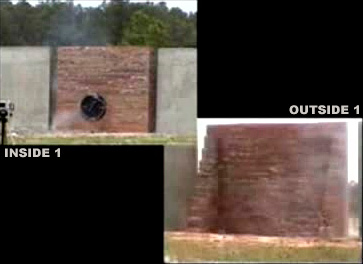
I have labeled the pictures according to how I imagine the kit being used at
the Pentagon. With the explosive force projected into the A-E drive and the
actual fiery explosion occurring inside the "C" ring. Notice that
it is placed dead center in the wall, the exact same placement of the hole at
the Pentagon. This test wall appears to be about twice as thick as the Pentagon
wall.
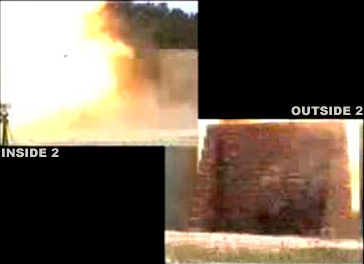
This is the detonation phase. You can see the white hot initial explosion (as
we do with frame 2 of the DoD video frames released from the front of the building).
You can see the wall is beginning to be compromised.
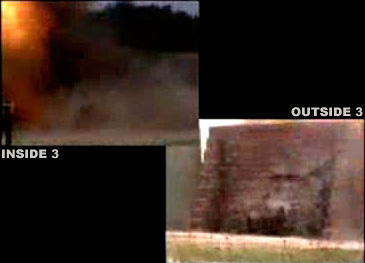
In this frame you can see that the white hot fireball has converted to the normal
by-products of combustion (just like frame 3 of the video from the front of
the building). The hole is starting to take shape.
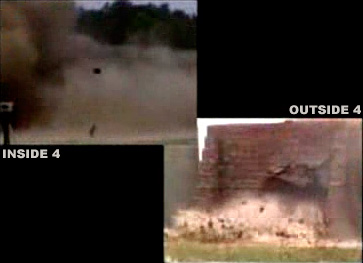
The hole is starting to look very familiar. Also note how the bricks are going
out in all directions but the bulk of the debris remains in the center with
a low trajectory. There is also no sign of fire or heat on this side of the
wall.

Here the hole is nearly identical to what we see in the A-E drive. For the
matter of space this will be the last frame I use (you can see the whole series
from the references at the bottom). Imagine what that debris would look like
if it were hitting a wall at about this point.
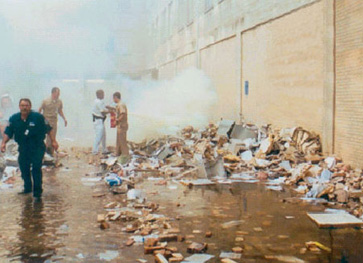
I wonder if it would look similar to this? Brick spread out in all directions
with the bulk of the debris in the center. This is a great photo to demonstrate
that there is NO impact on the "B ring" wall which would indicate
a solid object and no evidence of any large pieces of aircraft.
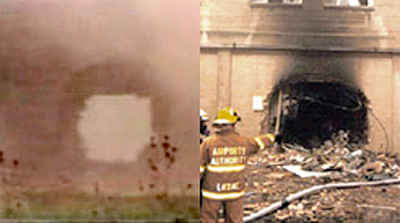
Look at the darker outer ring in the photo above. The inner diameter is smaller,
I believe due to the fact that the test wall is approximately twice as thick.
Look at the generally similar shapes of the inner holes. They both have an essentially
straight line across the top indicative of the horizontal nature of the bricks
and the sides have hints of straight lines in places.

The photo above is the back side of a concrete wall where the device was attached.
The photo on the right is the inside of the Pentagon exit hole. On the left
you can see the blast marks and the coloration. The hole on the left in this
case is obviously much smaller than the Pentagon exit hole. But do you see the
edge and color similarities? If the blackening in the photo on the right was
from a sustained fire then it also seems that there would have been flame visible
inside the first photo of the exit hole. Remember none of the debris sticking
out in the first photo were burned either. One other interesting item here is
that if the nose of an aircraft slid through here, there doesn't appear to be
any gouging on the floor!
Remember in this space the "back explosion" would be confined inside
the structure. It would put a lot of force on the walls and ceiling which may
explain why the second story windows above it are broken from the bottom possibly
from shock or vibration.
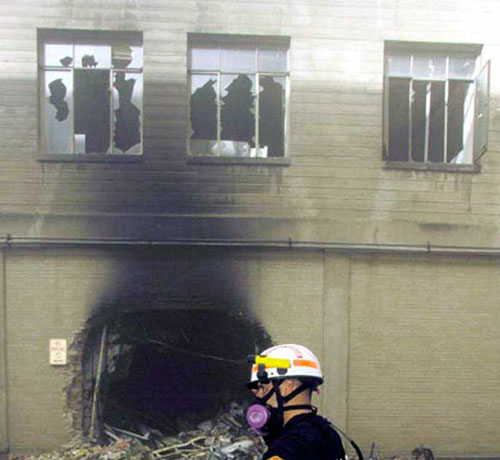
These windows were not broken by heat. There is no smoke coming from them and
the one to the right is out of the path. They were not broken by the fire department
for ventilation either. There was a 1 foot slab between the floors so no possible
fire travel and firefighter 101 is to break them at the very top for all ventilation.
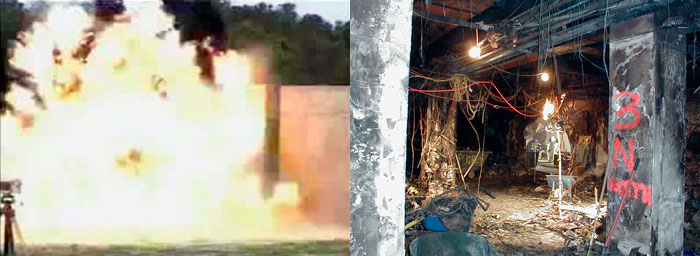
Above is what the back side of the explosion would look like inside the building.
On the right is another inside shot of the exit hole. If an explosion took place
from the back side of the wall into the Pentagon I would expect that the face
of the pillars away from the explosion would sustain limited damage. This is
the exact opposite of what we would expect if an aircraft/explosion were coming
from the left in this photo. But it is what we see - the pillars on the side
nearest to us are the least damaged. The pillar right behind the explosion would
be the most seriously damaged which is also what we see here. Another thing
to notice are the pipes running across the top of the ceiling. They do not seem
to have been impacted from the left as if from aircraft debris. They also are
not bent back away from the exit hole. I believe that is because of that steel
beam between them and the exit hole.
As I said at the top of this page I am not an explosives expert. The exit hole
I have mentioned before is one of the greatest anomalies at the Pentagon incident.
The nose of a plane is impossible and a ball of "energy" and debris
staying intact after navigating all of the interior and exterior walls, office
contents and pillars also seems unlikely. There has to be some reason that all
of the official reports refused to explain the exit hole. On this page we have
observed a possible mechanism that does makes sense and fits the evidence better
than any theory so far.
The last question is was there any evidence of secondary explosions recorded
at the Pentagon? The answer is here
. You can actually hear audio of one in the video at the bottom of the page.
Full Exit Hole Page -
http://www.pentagonresearch.com/exit.html
Rapid Wall Breaching Kit Product site -
http://www.ebaerospaceanddefense.com/defense/rapid_breaching.php

